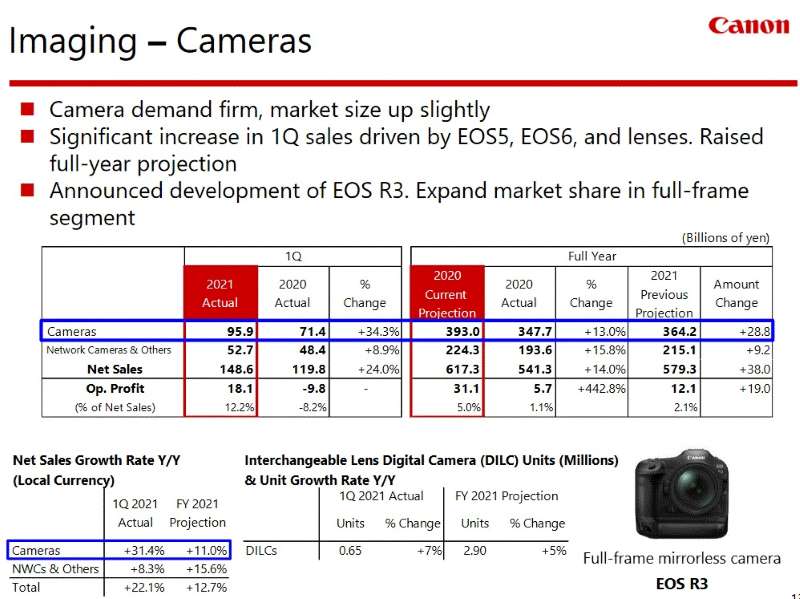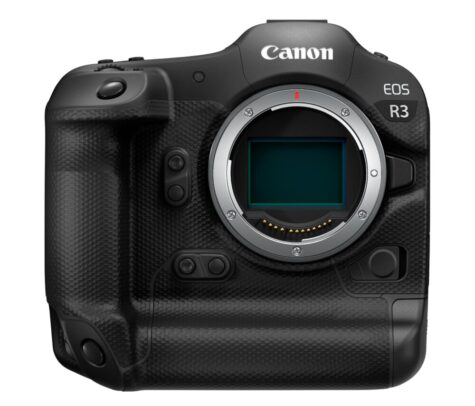Canon’s first quarter financial results are in line with the positive CIPA data for camera shipments from Jan-March, and see the market leader upgrading its forecast for the rest of 2021.
Canon camera sales were up 34 percent over the Covid-blighted first quarter of 2020, and Canon has upgraded its initial forecast for the full year by almost 30 percent, up from 364 to 393 billion yen.

It seems that the majority of this growth is due to an increase in average selling price for its cameras. In unit terms the growth rate compared to 2020 is a more modest 5 percent. This would be in line with Canon’s move towards full-frame mirrorless cameras and fewer entry-level DSLR sales.
‘Unit sales of both cameras and lenses exceeded our plan. Profitability improved significantly from last year due to a rise in average selling price and an increase in sales efficiency,’ said Canon CFO, Toshizo Tanaka.
However Canon has a more sober assessment of the mid-term prospects for the camera industry – it’s not getting too carried away with one pleasing quarter: ‘Because the size of the camera market is already approaching the number of users that are particular about visual expression, we expect the market to be limited to moderate contraction going forward,’ he explained. ‘As current sales of mainly new products are exceeding our plan, we raised our full-year projection for both sales and profit.’
It’s worth noting that Canon believes that just about everyone who wants a decent quality digital camera – ‘that are particular about visual expression’ – already has one. If it is correct in this belief – and you would expect the market leader to have a clue – then retailers should probably be cultivating closer relationships with existing camera-owning customers with a view to camera upgrades and lens and accessory sales.
The Canon CFO summarised the camera market as one where: ‘Even amid continued restrictions on people’s movement, demand for cameras remains solid, supported by the need for high–quality visual expression.
‘Based on this, we still expect the 2021 camera market to be up slightly or 5.8 million units. In the first quarter, revenue was significantly higher than last year, as sales remained strong, driven by the EOS R5 and EOS R6 which were launched in the second half of last year.
‘Additionally, the synergy effect of having competitive camera bodies and expanding our lineup of RF lens, which command high margins, led to an increase in average selling prices. This, and the establishment of efficient online sales activities nurtured through COVID–19 is leading to an improvement in profitability.
‘For the full year, reflecting the situation surrounding sales in the first quarter, we not only raised our projection for camera unit sales by 100 thousand to 2.9 million, but also raised our projection for revenue.

‘To further strengthen the mirrorless camera lineup, in April we announced the development of a new model, the EOS R3, which is equipped with a backside illumination stacked CMOS sensor that achieves high–speed signal processing, which allows for a number of functional improvements such as continuous shooting performance. At the same time, we announced 3 new RF lenses, bringing the total to 22 and we will continue to enhance this lineup going forward. By raising the appeal of the R series, we aim to further raising our market share in the full–frame category and increase sales.
‘Additionally, for new types of cameras, such as the PowerShotZoom that was launched at the end of last year and has attracted quite a bit of attention for its ease of capturing long–range images with one hand, we are steadily creating new markets.
This was the first quarter for Canon’s new business structure, where inkjet printers have been moved from the old Imaging buisness unit to a Printing business unit, and network cameras now share the Imaging business unit with still digital cameras. (The figures referred to above apply to digital still sales results.)
Inkjet sales have also been pleasing, with Canon struggling to meet demand in the first quarter: ‘In the first quarter, sales for inkjet printers were strong in each region to an extent that it was difficult to keep up with demand for mainly home–use models. Additionally, there were more opportunities to purchase low–end laser printer models for home use, which also led to sales increase.
‘In inkjet printers, we launched a top–of–the–line refillable ink tank model that excels not only in productivity through high–speed printing and double–sided scanning, but also in running cost, energy consumption and footprint. As a result, the number of models in our refillable ink tank product lineup has increased to 18, including the low–end models released in the fourth quarter of last year which offer improved maintainability.’





Be First to Comment